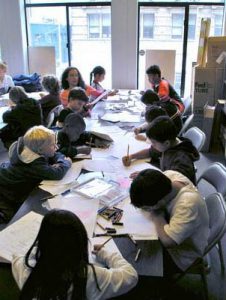Comics Create Literacy
Educators are increasingly viewing comic books as vital tools in teaching literacy, although comic books are usually tagged as the hindrance to education that students hide inside their backpacks. But modern educator’s view is, children are supposed to be reading comics rather than hiding them. In most cases, this modern approach dovetails with project learning.
According to Michael Bitz, founder and director of the Comic Book Project, creative projects can be a pathway to basic skills. Generally, the teachers have been able to engage children in spelling, punctuation, and vocabulary. But as the kids are creating the comic books themselves, they’re really invested in making these right, they want to spell words correctly.
 At the Newton D. Baker Elementary School of Arts, in Cleveland, sixth graders use the resources of the New York-based Comic Book Project to help them write and draw their own comic books under the joint tutelage of art instructor Sherri Pittard and reading teacher Gloria Doering. Doering works on other aspects of writing also, such as point of view. ” The point of view in their stories often jumps back and forth,” she says. “You’ll get waves of children who missed certain skills. As you’re editing the work, you’ll see what skills the students have not mastered yet.” So, this way the comics help not only to develop the kids’ drawing skills but also their writing skills and thought processings.
At the Newton D. Baker Elementary School of Arts, in Cleveland, sixth graders use the resources of the New York-based Comic Book Project to help them write and draw their own comic books under the joint tutelage of art instructor Sherri Pittard and reading teacher Gloria Doering. Doering works on other aspects of writing also, such as point of view. ” The point of view in their stories often jumps back and forth,” she says. “You’ll get waves of children who missed certain skills. As you’re editing the work, you’ll see what skills the students have not mastered yet.” So, this way the comics help not only to develop the kids’ drawing skills but also their writing skills and thought processings.
Even well-known comic strip authors such as Jim Davis, creator of the Garfield comics, have recognized and harnessed the teaching potential of comics on their Web sites. They believe the visual nature of comics can help teach children. When kids learn to read they are expected to infer meaning from text but inference is something really hard to teach young children, because it’s so abstract. Comics teach children to infer meaning from the visual first and then they begin to realize that not everything they read is literal. For example, comprehension means children have to be able to visualize what they are reading, and using comic strips can habituate them, or get them to think about that.
At 826 Valencia‘s writing-workshop program in downtown San Francisco, students create comic books to learn everything from plot diagrams to economy of words to onomatopoeia, the different forms of expressions. Instructor Jenny Traig says, “We talk a lot about using really good, satisfying words”, like – “What is the sound of slipping on a banana peel?”
Bill Zimmerman, creator of MakeBeliefsComix.com has found that people who teach English as a Second Language and who work with autistic children, among others, have found his site useful in their respective classrooms. “There’s a broad trend in terms of user groups,” he says. “I get email all the time from educators inside and outside the country who are using it”. This site that helps users make comic strips, received 200,000 visitors from more than 175 countries.
Comics inspire children towards education because comics make the whole process of learning a play not a difficult work.
